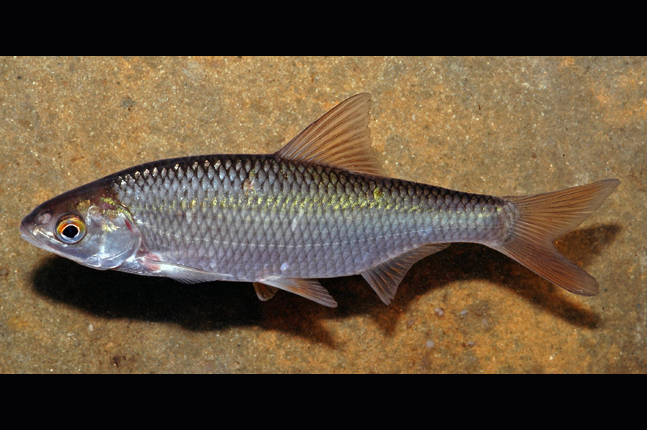Roach, Rutilus rutilus (Linnaeus 1758)

Roach, Rutilus rutilus. Source: Tarmo A. Raadik / Arthur Rylah Institute. License: All rights reserved
An introduced species orignally from Europe in the 19th century. The Roach is a silvery olive-green or dull bluish above, with bright silvery sides, a white belly, and orange to red pectoral, pelvic and caudal fins. It has a relatively deep body with a high arched back, a small head and mouth, a strongly forked tail and bright red eyes.
Roach, Rutilus rutilus (Linnaeus 1758)
More Info
|
Distribution |
Native to Europe. Introduced from Central Europe by acclimatisation societies to Tasmania between 1860 and 1870, and then to the Yarra River system in Victoria, New South Wales, and Western Australia. Roach were subsequently moved southwest of the Great Dividing Range in Victoria and are now in the Goulburn River system, north of the Great Dividing Range, and are in the Murray-Darling River system. The Roach has recently been reported from Port Stephens (New South Wales), however they are no longer found in Western Australia. They have probably been spread by anglers who use them as live bait. Usually inhabits still and slow-flowing rivers, lakes and ponds, especially amonsgt aquatic vegetation. The species usually lives in water temperatures of 8-25°C, but can reportedly tolerate temperatures of 0-38°C. They can have some tolerance of brackish water. |
|
Features |
Dorsal fin III, 9-11; Anal fin III, 9-11; Pectoral fin I, 15; Pelvic fin II, 8; Lateral line scales 40-45. Relatively deep-bodied, laterally-compressed, back arched; caudal peduncle relatively slender; tail distinctly forked; head small; snout blunt; mouth terminal, small, gape not reaching to front of eye; barbels around mouth absent; eye small, red; small axillary scale process present at pelvic-fin bases. Scales cycloid, of moderate size and firmly attached. Single, short-based dorsal fin positioned midway on back, somewhat square edged; anal fin short based, similar in shape to dorsal fin but not as high; pectoral fins low, well forward, somewhat pointed, anterior most rays longest; pelvic fins abdominal, somewhat pointed, with a small axillary process, inserted below dorsal fin; caudal fin deeply forked. |
|
Size |
Maximum size to 45 cm SL, 48 cm TL, commonly 15-20 cm SL. Large indivuals may weigh up to 2 kg. |
|
Colour |
Olive green on back, silver on sides and silvery white on belly; eyes bright red. |
|
Feeding |
An omnivore and zooplanktivore often seen feeding in schools. Juveniles feed on plankton, whereas adults are mostly bottom feeders eating mainly aquatic invertebrates and plants. They will also take terrestrial insects from the water surface. |
|
Biology |
The sexes are separate, and fertilisation is external. Males mature at 1-2 years and females at 2-3 years and females are egg layers (oviparous). The breeding season is from spring to early summer, and males develop nuptial tubercles on their pectoral fins before spawning. Females spawn between 5,000 to 200,000 demersal eggs that are attached to aquatic vegetation or onto tree roots, gravel or stones on the bottom. The eggs are small (~1-1.5 mm diameter), transparent and slightly adhesive. Larvae hatch in 4-10 days (dependent on water temperature) at 5-6 mm TL, and attach themselves to aquatic vegetatin before they become free swimming. Individuals can live to 18 years of age. |
|
Fisheries |
Although a popular food fish in eastern Europe, the Roach is not commonly fished by recreational anglers in Australia, where it is often regarded as a nuisance. The white flesh is considered to be poor eating. |
|
Remarks |
In South Australian waters, under the SA Fisheries Management Act, 2007, it is illegal to release fish species that are not native to South Australia into any SA waterway. Exotic species such as Roach out-compete native fishes for food and habitat, they may degrade water quality and may prey directly on native species. Primary Industry and Resources, South Australia. 2011. DAM SPECIES! Are you illegally releasing fish? Available online at http://www.pir.sa.gov.au/__data/assets/pdf_file/0009/157338/Dam_Species!_brochure_August2011.pdf |
|
Etymology |
"Rutilus" is from Latin, meaning reddish gold, presumably in reference to the coloration of the fins. |
|
Species Citation |
Cyprinus rutilus Linnaeus 1758, Systema naturae. Holmiae 10th ed: 324. Type locality: European lakes. |
|
Author |
Gomon, M.F. & Bray, D.J. 2015 |
Roach, Rutilus rutilus (Linnaeus 1758)
References
Allen, G.R., Midgley, S.H. & Allen, M. 2002. Field Guide to the Freshwater Fishes of Australia. Perth : Western Australian Museum 394 pp.
Arthington, A.H. & Bluhdorn, D.R. 1995. Improved Management of Exotic Aquatic Fauna: R&D for Australian Rivers. LWRRDC Occasional Paper No. 4/95. 36 pp.
Arthington, A. & McKenzie, F. 1997. Review of impacts of displaced/introduced fauna associated with inland waters. State of the Environment Technical Paper Series (Inland Waters). Department of the Environment : Canberra. 69 pp.
Cadwallader, P.L. & Backhouse, G.N. 1983. A Guide to the Freshwater Fish of Victoria. Melbourne : F.D. Atkinson Government Printer 249 pp. figs
Lintermans, M. 2004. Human-assisted dispersal of alien freshwater fish in Australia. New Zealand Journal of Marine and Freshwater Research 38: 481-501.
Lintermans, M. 2007. Fishes of the Murray-Darling Basin: an introductory guide. Murray-Darling Basin Commission, Canberra. 166 pp.
McDowall, R.M. (ed.) 1996. Freshwater Fishes of South-eastern Australia. Sydney : Reed Books 247 pp.
Merrick, J.R. & Schmida, G.E. 1984. Australian Freshwater Fishes Biology and Management. Sydney : J.R. Merrick 409 pp. figs 280 col. figs
Primary Industry and Resources, South Australia. 2011. DAM SPECIES! Are you illegally releasing fish? Available online at http://www.pir.sa.gov.au/__data/assets/pdf_file/0009/157338/Dam_Species!_brochure_August2011.pdf
Rowe, D.K., Moore, A., Giorgetti, A., Maclean, C., Grace, P., Wadhwa S. & Cooke, J. 2008. Review of the impacts of gambusia, redfin perch, tench, roach, yellowfin goby and streaked goby in Australia. Prepared for the Australian Government Department of the Environment, Water, Heritage and the Arts. Available online at: www.environment.gov.au/biodiversity/publications/index.html
Weatherley, A.J. & Lake, J.S. (1967). Introduced fish species in Australian waters. In Weatherley, A.H. (ed.) Australian inland waters and their fauna. Australian National University Press, Canberra.



